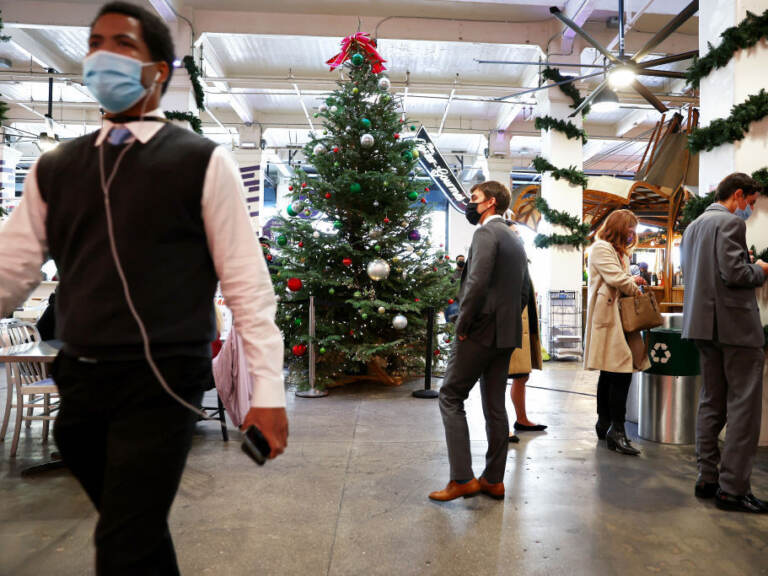As omicron spreads, health experts push for mask mandates. But few states have one

People wear face coverings inside Grand Central Market on December 15, 2021 in Los Angeles, California. California residents, regardless of COVID-19 vaccination status, are required to wear face masks in all indoor public settings beginning today. (Mario Tama/Getty Images)
A new statewide mask mandate in California took effect Wednesday, which brings the total number of states with mask mandates to just ten. At a moment when health authorities are warning of the fast spread of the highly infectious omicron variant, states with mask mandates are outliers.
This is true in places with huge surges, like Michigan, where there’s no mandate, despite hospitals overwhelmed with COVID-19 patients. There’s none in Ohio, where the legislature has taken away the governor’s authority on mandates. There’s none in New Hampshire, which currently has the most cases of COVID-19 per capita of any U.S. state, with 93 cases per 100,000 residents.
Even some counties and cities – like Nashville and Washington D.C., for example – that were pro-mask mandates earlier in the pandemic seem reluctant to bring them back.
Public health experts who track the pandemic are worried. Past experience with COVID-19 shows that when mitigation measures are put into place early, surges are smaller and end more quickly, which means more lives are saved.
“I’m a little mystified as to why we aren’t talking more about masking,” says Dr. Emily Landon, an infectious disease physician at the University of Chicago. “We want to avoid having hospitals be overwhelmed. We want to avoid having an impact on our economy. And the best way to do that is to keep cases as low as possible, and that means having a mask mandate in place.”
Here’s what we know about mask requirements and the role they can play in helping to slow the spread of COVID-19.
Can masks help stop omicron?
Given what’s known about the variant so far, yes. SARS-CoV-2 is still a respiratory virus, which means it’s still going to mostly spread from an infected person breathing, coughing or sneezing out the virus and someone else breathing it in. The difference with omicron is that it appears to be much more transmissible, meaning it’s even easier to catch it.
But a good mask will still make a difference in how much virus people spew out or take in, says Landon. On an individual level, that means it might be a good time to break out your best quality mask — an N95 or KN95 — especially if you’re traveling or going out in crowds in public. Also, if you’ve been letting your mask slide down under your nose, it’s a good idea to up your game and make sure your mask fits well.
Do mask mandates work?
There is evidence that mask mandates can help curb transmission. Recently, Rebecca Nugent, a data scientist at Carnegie Mellon who’s been tracking the impact of COVID-19 mitigation policies, looked at how the delta variant spread through the summer and fall.
She says, among states with similar vaccination rates, those with statewide mask mandates did better at containing the spread.
“While having a mask mandate doesn’t necessarily cease the spread, you can see a difference between ones that have kept a statewide mask mandate on and ones that haven’t,” she explains. She and her collaborators are still in the process of analyzing exactly how big of a difference mask mandates make on case numbers.
She also points out that, while county and local policymakers can and do often have mask requirements, keeping things at the local level requires residents to keep track of how the rules may change from county to county.
“It’s not reasonable or realistic to think that we’re containing spread by doing these little pockets of [policies] in different places,” she says. “Having the statewide mask mandate will, I think, help more with communication and compliance and reduce that uncertainty.”
Meanwhile, CDC’s current guidance is that everyone should be masking — vaccinated or not — in indoor public places in places where there’s high transmission, which is practically everywhere. But while the federal government has instituted and advocated for vaccine mandates, it hasn’t shown the same interest in requiring masks. President Biden’s omicron action plan barely mentions masks.
Even with mandates in place, will people comply or has pandemic fatigue and mask resistance set in for good?
Policymakers seem to have the impression that people are done with the pandemic rules – that they won’t comply anyway and it will just make them angry.
Landon, who actually worked to convince the governor of Illinois to keep that state’s mask mandate in place, says she’s frustrated with the idea that masks are a huge burden.
“I told the governor in my conversation with him, ‘You’ve got to stop talking about unmasking as though it’s a reward, because it perpetuates this belief that masks are somehow a penalty for the pandemic.'” she said. “It really isn’t — actually, it is quite literally the least we can do to protect other people.”
It’s possible that public resistance to masking is overblown. One survey of 993 people from Dec. 10-13, conducted by Ipsos and Axios, found that 64% of people nationally support state and local mask mandates, and that 69% of people reported that they are wearing masks either always or sometimes when they leave the house.
“It’s a balancing act for policymakers,” says Jennifer Tolbert, director of state health reform at the Kaiser Family Foundation. Throughout the pandemic, she says, “policymakers have been a little bit more reactive then than proactive, in part because of the politicization of some of these measures.” And she adds, “we’ve been at this for a long time now and there’s an exhaustion factor, too, with the public. So it is a challenge.”
If cases do start exploding in the U.S. as they have in the U.K., governors and mayors looking for new ways to curb the spread without putting lockdowns in place or closing down businesses may find mask mandates more appealing.
Still, some public health advocates warn that it’s better not to wait for the explosion of cases before introducing mitigation measures.
9(MDAzMzI1ODY3MDEyMzkzOTE3NjIxNDg3MQ001))


![CoronavirusPandemic_1024x512[1]](https://whyy.org/wp-content/uploads/2020/03/CoronavirusPandemic_1024x5121-300x150.jpg)


